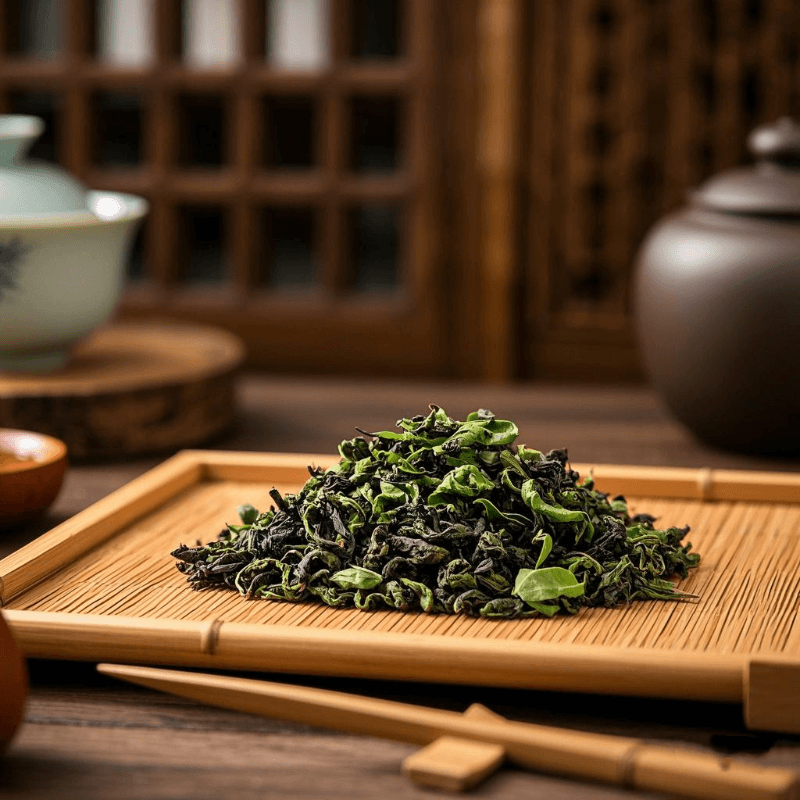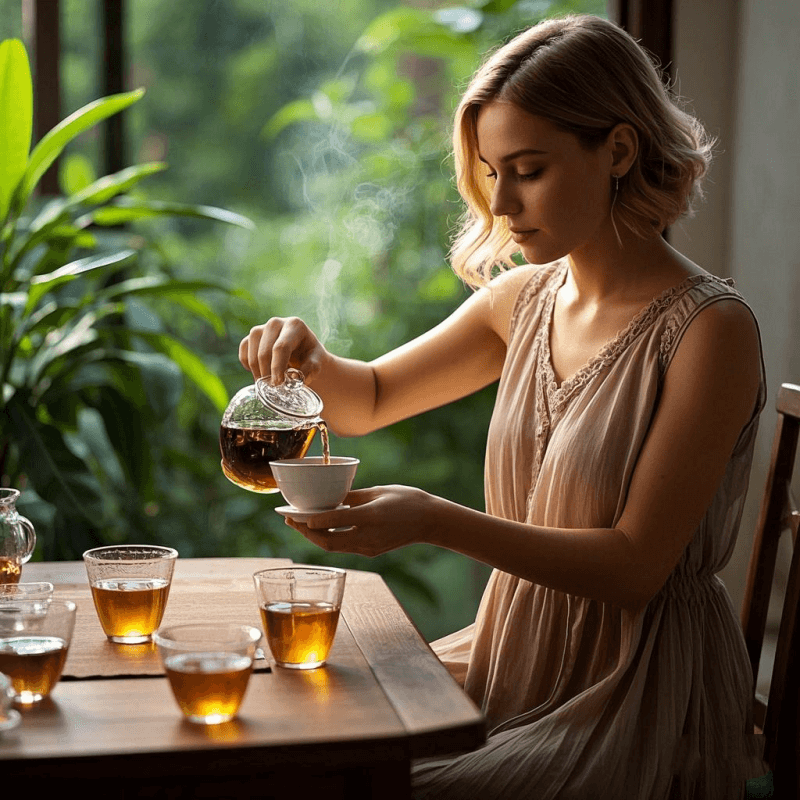
In the world of tea, loose leaf oolong tea stands as a pinnacle of quality and craftsmanship, captivating the palates of discerning enthusiasts. Unlike its bagged counterparts, this semi – fermented, whole – leaf beverage unfolds a rich and complex sensory journey, from the enchanting aroma that fills the air during brewing to the nuanced flavors revealed in each successive infusion. For those who seek the ultimate tea – drinking experience, loose leaf oolong tea is not merely a beverage—it’s a celebration of time – honored traditions and the artistry of tea – making.
This guide will explore the allure of loose leaf oolong tea, delving into its meticulous production process, numerous health benefits, optimal brewing techniques, and diverse flavor profiles that have made it a beloved staple among tea connoisseurs worldwide.
1. Introduction: Why Loose Leaf Oolong Tea Deserves More Attention
Tea enthusiasts around the globe are increasingly drawn to loose leaf oolong tea. But what is it about this particular brew that makes it so irresistible? At its core, loose leaf oolong tea embodies a perfect blend of quality, authenticity, and the art of tea – making.
“Once you’ve experienced the exquisite taste of loose leaf oolong tea, going back to bagged teas feels like a compromise,” remarks renowned tea sommelier Rachel Kim. “The depth of flavor, the complexity of aroma—it’s truly in a league of its own.”
From its superior taste extraction to its eco – friendly advantages, loose leaf oolong tea offers a plethora of benefits that resonate with both novice and seasoned tea drinkers. Let’s uncover what makes this tea truly exceptional.
2. What Is Loose Leaf Oolong Tea?
Loose leaf oolong tea hails from the Camellia sinensis plant, yet its form and production process set it apart from other tea varieties.
Production Process
- Harvesting: The leaves of this exceptional tea are often handpicked with meticulous care, ensuring that only the finest leaves and buds are selected. This careful approach allows for precise control over the final product’s flavor and quality.
- Processing: After harvesting, the leaves undergo a series of intricate steps, including withering, oxidation, rolling, and firing. The degree of oxidation, which can range from 8% to 85%, gives rise to the diverse and distinctive flavor spectrum characteristic of loose leaf oolong tea.
- Packaging: Unlike bagged teas, the whole leaves of loose leaf oolong tea are preserved in their natural state. This not only allows them to retain their integrity but also maximizes their flavor – releasing potential, ensuring a more satisfying and complex taste experience.
Types of Loose Leaf Oolong Tea
- Lightly Oxidized: Varieties such as Taiwanese high – mountain oolongs are celebrated for their delicate, fresh floral notes and subtle sweetness, offering a light and refreshing taste.
- Moderately Oxidized: Dong Ding oolong strikes a harmonious balance between roasted, nutty undertones and floral aromas, creating a well – rounded and flavorful cup.
- Highly Oxidized: Wuyi rock oolongs are known for their bold, earthy flavors, often with hints of smoke, providing a robust and intense tea – drinking experience.
For a more in – depth understanding of the history and benefits of this remarkable tea, [this comprehensive guide](https://www.healthline.com/nutrition/oolong – tea) from Healthline provides valuable insights.
3. The Benefits of Loose Leaf Oolong Tea Over Bagged Varieties
When it comes to choosing between loose leaf and bagged tea, loose leaf oolong tea offers several distinct advantages that set it apart.
Superior Flavor and Aroma

- Whole Leaves: The intact leaves of loose leaf oolong tea release their flavors and aromas gradually over multiple steeps. This slow infusion process allows for a more complex and evolving taste experience, with each steep revealing new layers of flavor. In contrast, bagged teas, often composed of broken leaves and dust, offer a quicker but less nuanced flavor profile.
- Quality Assurance: Producers of loose leaf oolong tea typically prioritize high – grade leaves, as the whole – leaf form showcases the true quality of the tea. Bagged teas, on the other hand, may use lower – grade blends or even tea dust to cut costs, resulting in a less flavorful and less satisfying cup.
Environmental Benefits
- Reduced Waste: By opting for loose leaf oolong tea, you eliminate the need for paper or plastic tea bags, which are often non – recyclable and contribute to environmental waste. Additionally, many tea enthusiasts reuse the leaves for multiple infusions, further minimizing their environmental impact.
- Sustainable Packaging: Loose leaf oolong tea is typically sold in reusable or recyclable containers, making it a more eco – friendly choice compared to bagged teas. This not only helps reduce waste but also supports sustainable practices in the tea industry.
Cost – Effectiveness
- Multiple Infusions: Loose leaf oolong tea can be steeped 5 to 7 times, yielding several cups of tea from a single serving. This makes it a more cost – effective option in the long run, especially when compared to single – use bagged teas, which are typically discarded after a single infusion.
Elevate your tea collection with premium loose leaf oolong tea selections that showcase the best of this beloved beverage.
4. Flavor and Aroma: What Sets Loose Leaf Apart
The flavor and aroma of loose leaf oolong tea are a testament to its exceptional quality and craftsmanship.
Complex Flavor Profiles
- Evolving Taste: Each steep of loose leaf oolong tea reveals new and exciting flavor notes, transitioning from light floral and citrusy tones in the early steeps to deeper, more complex flavors of fruit, spice, and even hints of chocolate or caramel in later infusions. This dynamic and ever – changing taste experience is what makes loose leaf oolong tea so captivating for tea lovers.
- Terroir Influence: Similar to fine wines, loose leaf oolong tea reflects the unique characteristics of its growing region, including soil composition, climate, and altitude. The loose – leaf form allows these terroir nuances to shine through more prominently, resulting in a more distinctive and memorable flavor profile.
Intense Aroma
- Aromatic Experience: The whole leaves of loose leaf oolong tea slowly release their essential oils as they steep, creating a rich and enticing aroma that fills the air. This aroma not only enhances the overall sensory experience but also provides a preview of the delicious flavors that await in each cup.
“Brewing loose leaf oolong tea is like embarking on a sensory adventure,” shares tea blogger Mark Johnson. “The aroma alone is enough to transport you to the lush tea gardens where the tea was grown, and the flavors that follow are nothing short of magical.”
Pair your loose leaf oolong tea with authentic oolong teaware designed to enhance every sip and fully appreciate the tea’s nuances.
5. Brewing Loose Leaf Oolong the Right Way
Brewing loose leaf oolong tea correctly is essential to unlock its full flavor potential. Here’s a step – by – step guide to help you brew the perfect cup:
Tools and Ingredients
- Teaware: A gaiwan, porcelain teapot, or Yixing clay pot is ideal for brewing loose leaf oolong tea, as these vessels help to retain the tea’s aroma and flavor. You’ll also need a tea strainer, a fair cup, and small tea cups for serving.
- Water: Use filtered or spring water for the best results. Tap water may contain impurities that can affect the taste of the tea.
- Tea Leaves: Use 5–7 grams (1–1.5 teaspoons) of loose leaf oolong tea per 150–200 ml (5–7 ounces) of water, adjusting the amount according to your taste preferences.
Brewing Steps
- Preheat Teaware: Pour hot water into the gaiwan, cups, and fair cup, then discard the water to warm the vessels. This helps to ensure that the tea brews evenly and maintains its temperature throughout the process.
- Add Tea Leaves: Place the loose leaf oolong tea leaves into the preheated gaiwan or teapot.
- Rinse Leaves: Pour 90–95°C (194–203°F) water over the leaves and immediately drain it. This quick rinse helps to remove any dust or impurities from the leaves and also awakens the tea, preparing it for brewing.
- First Steep: Pour hot water over the leaves and steep for 20–30 seconds, adjusting the time based on the type of loose leaf oolong tea and your personal taste preferences.
- Pour Tea: Strain the brewed tea into the fair cup to separate the leaves from the liquid. This helps to prevent over – steeping and ensures a consistent flavor in each cup.
- Serve: Distribute the tea from the fair cup into the serving cups and enjoy.
- Subsequent Steeps: For each additional steep, increase the steep time by 10–15 seconds to extract the remaining flavors from the leaves. You’ll be amazed at how the flavor of the tea continues to evolve with each infusion.
Explore a diverse collection of this tea to find your perfect match, and enhance your brewing experience with traditional tools designed to bring out the best in loose leaf oolong tea.
6. Who Should Choose Loose Leaf Oolong Tea and Why
Loose leaf oolong tea appeals to a wide range of individuals, each with their own unique reasons for choosing this exceptional tea.
Tea Enthusiasts
- Flavor Exploration: For those who love exploring new and exciting flavor profiles, loose leaf oolong tea offers an endless array of tastes to discover. From the delicate floral notes of lightly oxidized varieties to the bold, earthy flavors of highly oxidized oolongs, there’s a loose leaf oolong tea to suit every palate.
- Brewing Ritual: The process of brewing loose leaf oolong tea, from selecting the right teaware to carefully measuring the leaves and steeping them to perfection, is a ritualistic and meditative experience that many tea enthusiasts find deeply satisfying.
Health – Conscious Individuals
- Antioxidant – Rich: Packed with antioxidants such as catechins and theaflavins, loose leaf oolong tea is known to offer a range of health benefits, including supporting heart health, aiding in weight management, and reducing the risk of chronic diseases. As highlighted in [this WebMD article](https://www.webmd.com/diet/features/oolong – tea – benefits), the antioxidants in loose leaf oolong tea can help protect the body against oxidative stress and inflammation.
Environmentally – Minded Consumers
- Sustainable Choice: Choosing loose leaf oolong tea is a step towards reducing waste and supporting sustainable practices. By eliminating the need for tea bags and opting for reusable or recyclable packaging, you can make a positive impact on the environment while enjoying a delicious cup of tea.
7. Conclusion: Embrace the Tradition of Loose Leaf Oolong Tea
Loose leaf oolong tea is more than just a beverage—it’s a celebration of tea culture, a source of health benefits, and a sensory delight. Whether you’re drawn to its complex flavors, health advantages, or sustainable nature, this semi – fermented tea offers an unparalleled experience that is sure to satisfy even the most discerning palate.
Ready to embark on your own tea adventure? Discover our curated collection of this tea and explore traditional brewing tools to savor every nuance of loose leaf oolong tea. Embrace the world of loose leaf tea and indulge in the exquisite pleasures it has to offer.

Pingback: Top 7 Oolong Tea Amazon Bestsellers 2025: Shopper Favorites
Pingback: Oolong Loose Leaf Tea: Master Brewing for Rich Flavor & Health Benefits